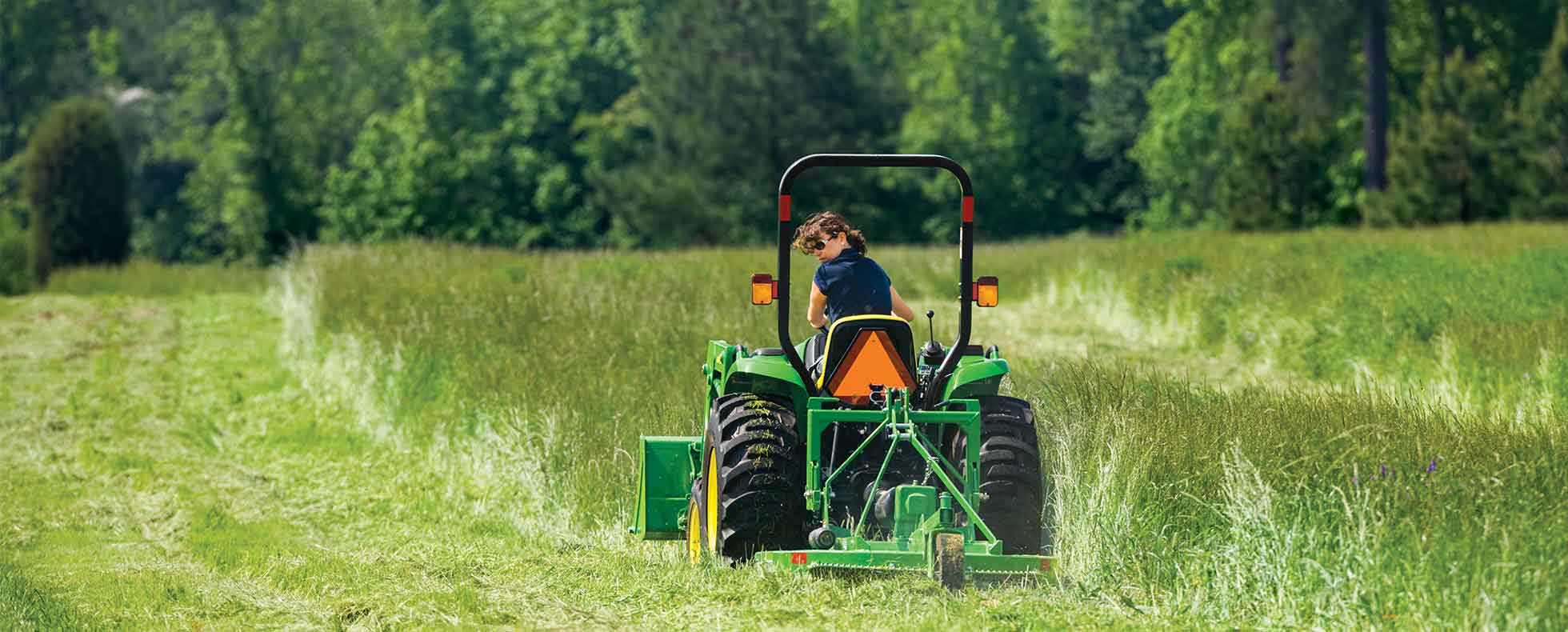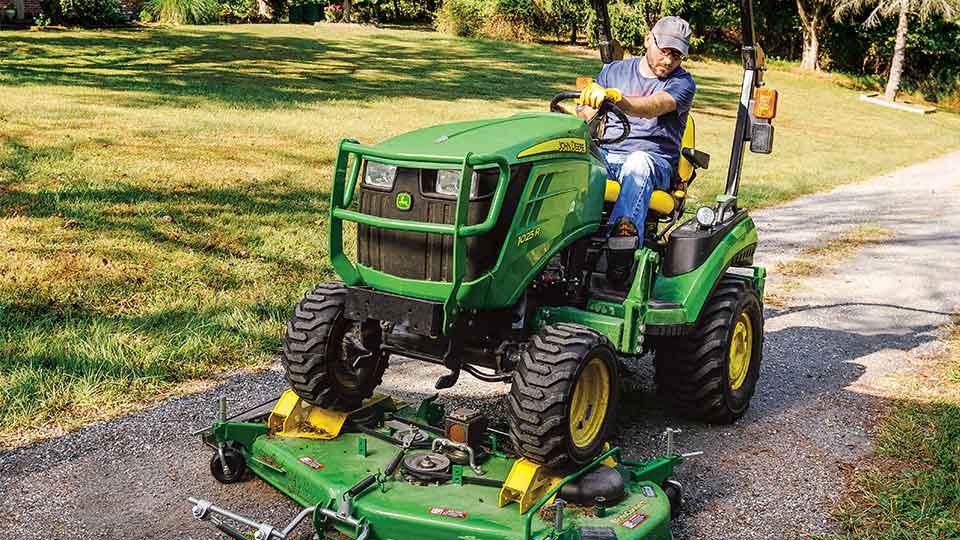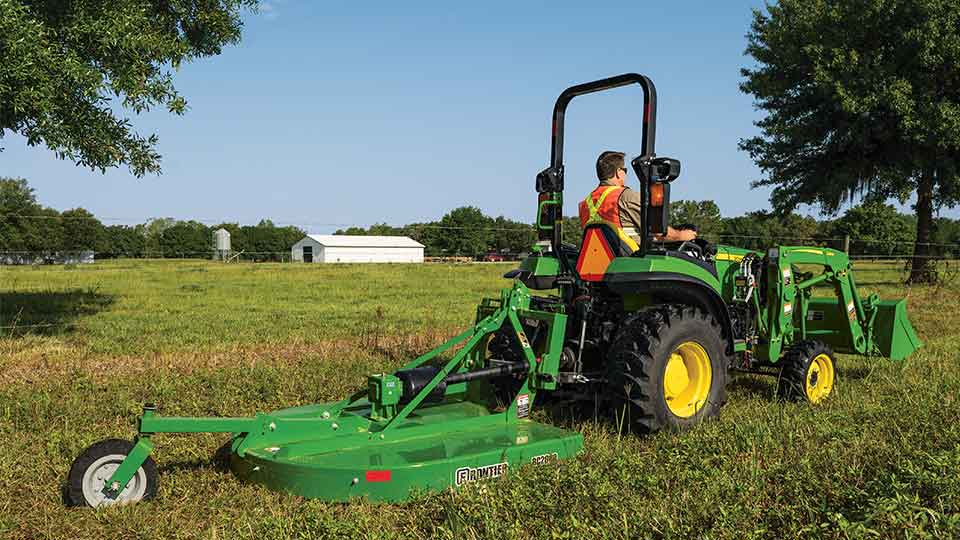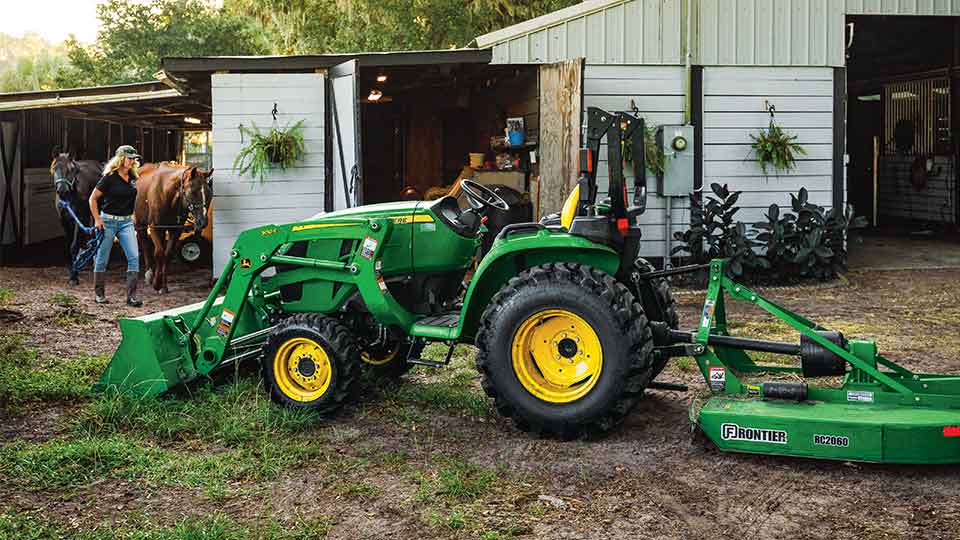
Buying a new compact tractor can be exciting. You’re picking out a machine you can reasonably expect to have for the next 10, 20, or even 30 years.
With so many options in John Deere’s compact tractor catalog, it can be challenging to pinpoint the best fit for you.
What size, horsepower and lifting capacity do you need? Which series should you go with?
Our experts are here to answer these questions and more. Here at RDO Equipment Co., we’ve been selling John Deere machinery, equipment and parts for over 50 years. Every day, our teams help connect customers like you with the best machinery to meet their needs.
This article will give an overview of your John Deere compact tractor options and offer three tips for making this choice to help you decide on a compact tractor.
John Deere has been producing compact tractors since 1976. Over the years, its compact offerings have grown, and today, they consist of four series and more than twenty models.
Here’s an overview of each compact tractor series.
The 1 Series of compact tractors are technically considered “sub-compact.” John Deere offers two models in this line — the 1023E and 1025R.
These sub-compact tractors are popular with residential customers, offering a small frame, 57.1-inch wheel base, 758-pound lifting capacity and three-cylinder diesel engines.
The variance between the two models is slight.
In terms of features, John Deere categorizes machines into either E, M, R or D.
E Series compact tractors have the fewest extra features, while R Series (the top end) have the most.
The 1025E is slightly lighter and has less horsepower than the 1025R.
It also lacks 1025R features like cruise control and a cab option. Both models are compatible with hundreds of attachments, including up to a 60-inch drive-over mower deck.

Typically, we see homeowners purchasing 1 Series compact tractors for grass mowing, snow blowing (in the northern U.S.) and other light landscaping needs.
Referred to as the “ultimate mini landscaper,” John Deere’s 2 Series compact tractors increase in size.
In this product line, you have the 2025R, 2032R and 2038R.
These are slightly larger machines compared to the 1 Series. They feature 63- (2025R) to 67.8-inch wheelbases, more horsepower and a loader lifting capacity of up to 1,356 pounds.
The engines also get an upgrade, giving you plenty of power to tackle heavy lifts, pulls and pushes, along with other intensive tasks.
Like the 1 Series, these compact tractors are compatible with all kinds of attachments, from pallet forks to stump grinders to snow blower implements. 2 Series compact tractors are also compatible with up to a 72-inch mower deck.

Commonly, 2 Series compact tractors are a great fit for people who do landscaping and other work on larger residential or rural properties. An example would be a lake house with an acre of land, or a house with a large backyard to mow, trees to remove and a long driveway to plow.
At this point, we’re getting into the large end of John Deere’s compact tractor lineup.
Nine options are available in the 3 Series, which range between 25 and 46 horsepower. These tractors are larger than their 1 and 2 Series counterparts, featuring up to 2,200 pounds of loader lift capacity, a 62-68-inch wheelbase and 2,645-4,079 pounds of rear axle capacity.
These tractors are compatible with John Deere and third-party attachments, and three-point implements.
The 3 Series is also the first time cab heating and air conditioning are available (in the R Series). This is the only series featuring D Series products — 3025D, 3035D and 3043D — which have a reliable, and cost-effective gear-driven transmission.

John Deere’s 3 Series is getting up there in size.
Typically, it’s not necessary if you’re doing projects like mowing your lawn, lifting logs or blowing snow. Instead, consider a 3 Series tractor when caring for larger tracts of land (an acre or larger), mowing deer trails, tending small hobby farms or doing light construction work like scraping driveways.
These are also often used by landscaping companies.
There are currently nine models in John Deere’s 4 Series, which range between 44 and 75 horsepower. This is the largest series of compact tractors John Deere makes.
This series offers a 73-inch wheelbase, 2,500-pound lift capacity, 5,292-pound rear axle capacity and cruise control on all models. The 4 Series also offers heavy-duty models with more robust construction and tires.
You’ll find M and R Series in this class, but not E.
Within the R Series, you’ll receive updated features, including air conditioning/cooling within its cab, aux hitch control and hitch assist.
These are the largest small-frame utility tractors in John Deere’s lineup. We recommend them to people with significant landscaping, light farming and personal construction needs.
These are often a good addition to commercial fleets looking for a versatile landscaping, forestry and construction tool.
If you are a consumer who regularly performs large-scale property maintenance, whether it’s farming and ranching duties, or something else, consider the 4 Series.
In the Midwest, we see many people purchasing these to tend their food plots before hunting season, for example.
Now that we’ve overviewed the four compact tractor series in John Deere’s lineup, let’s talk about choosing the best one for you. This is a big decision as you’re selecting an item that could last you decades.
Here are three tips for choosing a compact utility tractor.
The first thing we encourage customers to do when looking for a new John Deere compact tractor is to evaluate what they’ll use it for.
The 1025E is the most popular option for residential customers who need to mow grass, blow snow and move heavy items around their lot. In many cases, it is the best entry-level compact utility tractor.
Here are some factors to consider as you evaluate your needs:
As your needs become more complex, it starts to make sense to opt for an option beyond the 1 Series. It’s not uncommon for people with larger properties to need an upgrade over time as their needs grow.
For people who have a lot of land and do a fair amount of work on it (cutting trees, removing stumps, moving hay bales, tilling dirt, working in ditches, mowing grass, etc.) the 3-4 Series can make a lot of sense.

Price is a major consideration when choosing one of these machines. Each series (1-4) has tiers to buy within. So, once you have a breakdown of your needs, you should consider price.
The E Series is the most price-friendly of these lines. After that, everything gets more expensive.
Here are some general price ranges for each series, not including special offers.
Prices will differ by product in each of these ranges. As such, weigh your needs and consider your budget to pinpoint the best option.
The third thing to think about when choosing a John Deere compact tractor is the exact product features you’re looking for. Mostly, compact tractors in a series can perform similar jobs. Much of this choice comes down to specific features and amenities.
For example, if you’ll be using your machine in the dead of Minnesota’s winter, maybe having a heated cab is essential.
Our advice is to go to your local RDO Equipment Co. and test drive a few of the tractors you’re considering. Our product experts can also help you make these decisions by answering questions and pointing you in the right direction.
As you look for a new compact utility tractor, you’ll find many options. If this is your first time purchasing one, it can be overwhelming.
With more than 20 John Deere compact tractor options, it’s important to consider your needs, budget and any features you must have before proceeding.
Your next step is to explore the series (1-4) you feel could be your best fit by checking its product details and specifications.
If you have any questions or are ready to request a quote, reach out to us here.